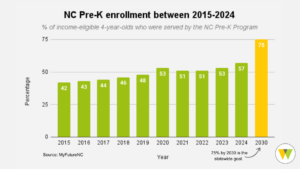By Amy Cockerham
Public Ed Works
RALEIGH (September 10, 2025) – Legislators’ refusal to properly fund education even affects our youngest learners in North Carolina.
Research shows pre-kindergarten can be a crucial stage to a child’s development. North Carolina has a high-quality Pre-K program, but the state isn’t serving all the kids it can.
Last year, NC Pre-K enrolled 27,928 children, only 57% of about 49,000 four-year-olds from lower-income families who were eligible.
Jenna Ramsey, Director of Wake County Public Schools Preschool Programs, knows first-hand the difference preschool can make in a child’s life.
“There has been a plethora of research done regarding the positive effects,” Ramsey said.
“We know that children that receive Pre-K are more likely to be able to graduate on time, attend college and are more likely to have higher test scores in elementary schools.”
Ramsey said NC Pre-K primarily serves children whose families gross income is at or below 75% of the state median income.
“I definitely think we need to expand capacity, and that means creating more seats to serve a higher percentage of our eligible students,” Ramsey said.
“I think we also need to support the workforce in general, whether teachers are in the private sector or in the public school system. Our preschool teachers continue to deserve competitive compensation.”
SO WHY aren’t we able to serve all the kids we should be serving?
Enrollment in NC Pre-K grew steadily between 2001—when the More at Four Pre-Kindergarten Program was established—and 2009, when enrollment peaked at nearly 33,800.
But in the years after that, state legislators budgeted less for the program and only 26,780 children were served in NC Pre-K in 2015-16 – 7,000 fewer than in 2009, despite a burgeoning state population.
Funding expansions that began in 2017 increased enrollment in the 2019-20 school year to more than 31,000, representing 53% of eligible children.
But following that, the number of children served decreased by about 900 in 2020-21, by about 200 more in 2021-22, by another 100 in 2022-23, and by 1,914 in 2023-24, the largest decrease since the 2017 expansion.
A glaring issue under North Carolina’s funding model is that the state pays about 60% of the cost, and the local community pays 40%. Many of the state’s poorest counties do not have funds to cover their portion, so they wind up forfeiting the state funds.
“It’s just dependent county to county,” Ramsey said. “When counties have a high priority on early childhood, they do tend to be able to figure out ways where local funding can be contributed.”
By 2030, North Carolina needs 8,686 more low-income 4-year-olds to participate in NC Pre-K to meet the statewide goal of 75% enrollment of eligible children in each county.
“We are having a difficult time based on a variety of different funding streams, being able to have all the funding that we need to be able to support all of the students that might benefit,” Ramsey said.
“I mean the core issue is really a funding gap.”
WHY IS IT our legislators will not properly fund access to Pre-K when research clearly shows the advantage of it for children? Is it that they don’t care? Or maybe they won’t accept proven facts and research?
We clearly have the resources, given the hundreds of millions of dollars in taxpayer-funded vouchers we lavish on students who already attend private schools.
Or is it that we voters don’t understand or don’t care?
Our legislators should be held accountable.
This is the latest installment of our “Lessons Learned” series aiming to address how legislative actions – and inaction – in North Carolina over the past few decades have contributed to harm in our public schools. For a chronicle of our previous work, click here.



Leave a Reply